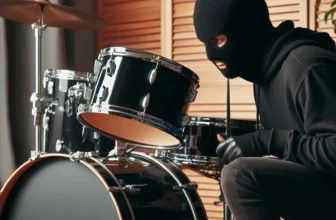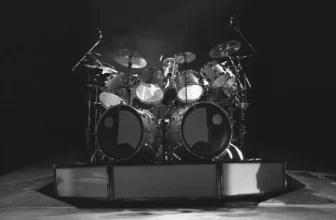How Often Should You Change Your Drum Heads?


Are you wondering how often you should be changing out your drum heads? In this article, we’ll break it down for every drummer—from the hobbyist to the professional touring player.
One of the most contested topics between drummers is the debate on how often you should change your drum heads. Some believe you need to replace them after every show, while others claim never to change them at all.
You should change your heads out every three to six months when gigging and touring. This length ensures decent-sounding drums at a relatively affordable cost. Always change out your drum heads before a recording session.
Drum heads are expensive, and since I don’t like wasting my money, I try to get as much use out of every head as possible.
There are ups, downs, and nuance to both sides of the argument — I’ll give my two cents as well as advice for all drummers, regardless of experience.
Why Change Drum Heads?
Should we replace them at all? The answer is yes.
After taking a beating from us drummers, heads tend to lose their responsiveness and tone. Drum heads also become weaker, often breaking.
Responsiveness is to jump on a trampoline — your stick’s rebound can be affected by old drum heads. While this likely isn’t going to be that noticeable, it is a thing.
Loss of tone is arguably the most significant contributing argument for changing drum heads. Over time, the drum head stretches and contorts — this is normal when applying the skin (it’s advised to break the glue in by using pressure with your hand when the head is on).
After a long duration (six months to a year), the drum head becomes over-stretched and may begin to sound dissonant and out of tune, no matter how well you try.

You may think that you’re the only one who can tell the drum is out of tune, but you aren’t. Out of tune drums sound terrible and contain many harsh overtones that are annoying to the ear.
The only exception to the rule would be practice heads. If you use your drums strictly for practice, you can use a set of drum heads until they break. Despite the poor tonal quality, I don’t see any point in wasting money unless you want your drums to sound good while practicing.
How Often For Me?
Depending on your experience and budget, the answer will vary.
Beginning Drummers
For new drummers with a new kit, I wouldn’t even think about changing heads for the first year. Get yourself acquainted with playing, feel, and drum tuning.
On most reputable kits, the stock heads aren’t too bad and often are from the big brands like Remo and Evans — this is not the case with beginner kits from Mendini or Gammon.
If you eventually feel curious about the tone and sound quality of your drums, start looking at drum heads.
If you have no idea where to begin, I’d suggest trying the following (remember to look at what size your drums are):
- Snare Top — Remo Controlled Sound Reverse Dot
- Snare Bottom — Remo Ambassador Hazy Snare Side
- Tom Tops — Remo Emperor Coated
- Tom Bottoms — Remo Ambassador Clear
- Kick Drum — Remo Powerstroke Pro
Now I may be a little partial to Remo, but you don’t have to be. There’s plenty of other great options from companies like Evans, Aquarian, and Attack.
I’m assuming since you’re a new drummer, this kit most likely won’t be at a gig anytime soon. In that case, you can use this set of heads for quite a while.
Touring Drummers
If you’re playing live and around the country, you may be wondering how often to change heads. I don’t switch out heads often — once or twice per tour at most.
Playing club shows are often imperfect. I’ve found there usually isn’t a lot of time for changing heads and tuning — especially if you’re responsible for other facets of the show, like audio and production.
For this reason, I only change heads once or twice on tour. It’s a luxury when you get the chance to tune your drums and switch out heads.
You may think there is ample time, but it is rather difficult to change heads and tune drums with another band sound-checking on stage.
Before Hitting The Recording Studio
All recording engineers will tell you to change to new heads before stepping foot in the studio. I couldn’t agree more.
Changing heads improves the sound of a recording drastically. Drums with new heads are full of life and energy. Drums with old skins tend to sound dull and uninspiring.
How Often? — Top Head Vs. Bottom Head
The bottom head (resonant) will last longer by a long shot. The top skin (batter) takes a beating day in day out, so it’s no wonder why we need to change it more often.
For new drummers, don’t worry about changing the bottom heads for now. I didn’t switch out my first kit’s resonant heads for years when I was learning how to play.
I did, however, change the batter heads frequently, probably once a year while I was learning. These days, I change my heads every three to six months on average. Everyone’s playing style is different, so your mileage will vary.
Things To Notice as Drum Heads Age
As you play, you will notice a little wear and tear on your heads. Here’s what you’ll see.
Dents — As your stick strikes the head, it’s bound to leave some dents. Depending on what type of drummer, you are also has a significant impact. If you’re more of the hard-hitting type, expect to see more dents.
Worn Away Coating — For those using coated heads (heads sprayed with a white grit for fewer overtones and increased brush response), the coating will slowly wear away. I mostly notice the grippy coat dissolving, but in some cases, you’ll be able to see right through the head.
Broken Heads — This one is a little more obvious, but still poses a significant issue. Split heads sound terrible. If you play harder music like rock or metal, it will be easier to break heads, but not that common.
The bass drum head tends to break the easiest, so to protect your head I recommend using Remo’s Falam Salm. The Falam Slam is a small patch that adheres to the center of your kick drum head where the beater(s) meets the head. I can’t stress the use of this accessory enough. Kick drum heads are expensive; protect it!
“Lifeless” Sound — There is a certain “magic” you hear when hitting a new drum head for the first time. After six months of heavy use, that magical sound has long gone.
So with that said, how often to do you change out your drum heads? Please let me know down below in the comments and if you have any questions, feel free to ask. Thanks for reading!




